Lightning Performance of Copper-Mesh Clad Composite Panels: Test and Simulation
Abstract
:1. Introduction
2. Multi-Field Coupling Simulation Analysis
2.1. Finite Element Method (FEM) Formulation
2.2. Numerical Results
3. Lightning and Eddy Current Tests
3.1. Test Setup
3.2. Test Results
4. Comparison between Simulation and Tests
5. Conclusions
- Analyzing the stress nephogram of the copper net and carbon fiber panel in the simulation, the lightning damage of the material under the current load of 100 kA and 200 kA can be obtained. By comparing the damage morphology of carbon fiber panel in simulation and lightning test, it is proved that the simulation results are aligned with the experimental data.
- Comparing the damage of carbon fiber panel under 100 kA and 200 kA current loads, the protective effect of the copper net is obvious at 100 kA since the panel does not appear fracture damage. However, the panel is damaged along the stress concentration area under 200 kA and the copper mesh is also severely damaged. Therefore, the metal shield has a certain limit in the protective of the lightning strikes.
- There is no significant residual thermal stress in the direction of the layer thickness, which means that the copper net can play a role of energy absorption protection for the carbon fiber laminates subjected to actual lightning current impact.
Author Contributions
Funding
Acknowledgments
Conflicts of Interest
References
- Garcia, C.; Trendafilova, I.; Zucchelli, A. The effect of polycaprolactone nanofibers on the dynamic and impact behavior of glass fibre reinforced polymer composites. J. Compos. Sci. 2018, 2, 43. [Google Scholar] [CrossRef]
- Garcia, C.; Trendafilova, I. Triboelectric sensor as a dual system for impact monitoring and prediction of the damage in composite structures. Nano Energy 2019, 60, 527–535. [Google Scholar] [CrossRef] [Green Version]
- Gagné, M.; Therriault, D. Lightning strike protection of composites. Prog. Aerosp. Sci. 2014, 64, 1–16. [Google Scholar] [CrossRef]
- Patsora, I.; Heuer, H.; Hillmann, S.; Tatarchuk, D. Study of a particle based films cure process by high-frequency eddy current spectroscopy. Coatings 2016, 7, 3. [Google Scholar] [CrossRef]
- Katunin, A.; Krukiewicz, K.; Turczyn, R.; Sul, P.; Łasica, A.; Bilewicz, M. Synthesis and characterization of the electrically conductive polymeric composite for lightning strike protection of aircraft structures. Compos. Struct. 2017, 1597, 73–83. [Google Scholar] [CrossRef]
- D’amore, M.; Sarto, M.S.; Scarlatti, A. Radiated susceptibility of wiring system aboard lightning struck aircraft. Part I: Sensitivity to the p.u.l. external parameters. In Proceedings of the IEEE International Symposium on Electromagnetic Compatibility, EMC 2002, Minneapolis, MN, USA, 19–23 August 2002; Volume 1, pp. 65–70. [Google Scholar]
- Larsson, A. Introduction to aircraft lightning attachment. In Proceedings of the IEEE International Symposium on Electromagnetic Compatibility, EMC 2008, Detroit, MI, USA, 18–22 August 2008; pp. 1–9. [Google Scholar]
- Alemour, B.; Badran, O.; Hassan, M.R. A review of using conductive composite materials in solving lightening strike and ice accumulation problems in aviation. J. Aerosp. Technol. Manag. 2019, 11, e1919. [Google Scholar] [CrossRef]
- Qiu, G. Lightning protection of aircraft. Environ. Technol. 1985, 2, 21–26. (In Chinese) [Google Scholar]
- Uman, M.A.; Rakov, V.A. The interaction of lightning with airborne vehicles. Prog. Aerosp. Sci. 2003, 39, 61–81. [Google Scholar] [CrossRef]
- Yin, J.J.; Chang, F.; Li, S.L.; Yao, X.L.; Sun, J.R.; Xiao, Y. Experimental and numerical simulation analysis of typical carbon woven fabric/epoxy laminates subjected to lightning strike. Appl. Compos. Mater. 2017, 24, 1353–1372. [Google Scholar] [CrossRef]
- Lauque, P.; Lebey, T.; Mayoux, C.; Guillaumon, J.C. Electrical study of new coating materials for aircraft lightning protection. In Proceedings of the 3rd International Conference on Properties and Applications of Dielectric Materials, IEEE 1991, Tokyo, Japan, 8–12 July 1991; pp. 623–626. [Google Scholar]
- Monavon, M.; Leroy, M. Numerical simulation of cruiser or aircraft lightning (Simulation numerique du foudroiement d’un croiseurou d’un avion). Electron. Lett. 1987, 23, 640–642. [Google Scholar] [CrossRef]
- He, T.; Sherman, B.D.; Nozari, B.; Rudolph, T. Time domain finite difference validation for transport aircraft lightning induced effect studies. In Proceedings of the 1995 IEEE International Symposium on Electromagnetic Compatibility, Atlanta, GA, USA, 14–18 August 1995; pp. 359–364, Symposium Record. [Google Scholar]
- Rao, P.; Shamanna, K.N.; Nagabhushana, G.R. Lightning test facility for light combat aircraft. In Proceedings of the International Conference on Electromagnetic Interference and Compatibility ’99 IEEE, Hyderabad, India, 8 December 1997; pp. 391–394. [Google Scholar]
- Ballas, G.; Balanis, C.A. Modeling of lightning effects on simple structures and helicopter airframes using FDTD. In Proceedings of the IEEE Antennas and Propagation Society International Symposium, Orlando, FL, USA, 11–16 July 1999; Volume 1, pp. 598–601. [Google Scholar]
- Perrin, E.; Guiffaut, C.; Reineix, A.; Tristant, F. Using a design-of-experiment technique to consider the wire harness load impedances in the FDTD model of an aircraft struck by lightning. IEEE Trans. Electromagn. Compat. 2013, 55, 747–753. [Google Scholar] [CrossRef]
- Hirano, Y.; Katsumata, S.; Iwahori, Y.; Todoroki, A. Artificial lightning testing on graphite/epoxy composite laminate. Compos. Part A Appl. Sci. Manuf. 2010, 41, 1461–1470. [Google Scholar] [CrossRef]
- Feraboli, P.; Kawakami, H. Damage of carbon/epoxy composite plates subjected to simulated lightning strike. J. Aircr. 2010, 47, 999–1012. [Google Scholar] [CrossRef]
- Rajesh, P.S.M.; Sirois, F.; Therriault, D. Damage response of composites coated with conducting materials subjected to emulated lightning strikes. Mater. Des. 2018, 139, 45–55. [Google Scholar] [CrossRef]
- Guo, Y.; Xu, Y.; Zhang, L.; Wei, X.; Dong, Q.; Yi, X.; Jia, Y. Implementation of fiberglass in carbon fiber composites as an isolation layer that enhances lightning strike protection. Compos. Sci. Technol. 2019, 174, 117–124. [Google Scholar] [CrossRef]
- Wang, B.; Duan, Y.; Xin, Z.; Yao, X.; Abliz, D.; Ziegmann, G. Fabrication of an enriched graphene surface protection of carbon fiber/epoxy composites for lightning strike via a percolating-assisted resin film infusion method. Compos. Sci. Technol. 2018, 158, 51–60. [Google Scholar] [CrossRef]
- Hirano, Y.; Yokozeki, T.; Ishida, Y.; Goto, T.; Takahashi, T.; Qian, D.; Ito, S.; Ogasawara, T.; Ishibashi, M. Lightning damage suppression in a carbon fiber-reinforced polymer with a polyaniline-based conductive thermoset matrix. Compos. Sci. Technol. 2016, 127, 1–7. [Google Scholar] [CrossRef]
- Abdelal, G.; Murphy, A. Nonlinear numerical modelling of lightning strike effect on composite panels with temperature dependent material properties. Compos. Struct. 2014, 1092, 68–78. [Google Scholar] [CrossRef]
- Guo, Y.; Xu, Y.; Wang, Q.; Dong, Q.; Yi, X.; Jia, Y. Eliminating lightning strike damage to carbon fiber composite structures in Zone 2 of aircraft by Ni-coated carbon fiber nonwoven veils. Compos. Sci. Technol. 2019, 169, 95–102. [Google Scholar] [CrossRef]
- Morgan, J. Thermal simulation and testing of expanded metal foils used for lightning protection of composite aircraft structures. SAE Int. J. Aerosp. 2013, 6, 371–377. [Google Scholar] [CrossRef]
- Black, S. Lightning strike protection strategies for composite aircraft. High Perform. Compos. 2013. [Google Scholar]
- Chakravarthi, D.K.; Khabashesku, V.N.; Vaidyanathan, R.; Blaine, J.; Yarlagadda, S.; Roseman, D.; Zeng, Q.; Barrera, E.V. Carbon fiber–bismaleimide composites filled with nickel-coated single-walled carbon nanotubes for lightning-strike protection. Adv. Funct. Mater. 2011, 21, 2527–2533. [Google Scholar] [CrossRef]
- Dong, Q.; Wan, G.; Xu, Y.; Guo, Y.; Du, T.; Yi, X.; Jia, Y. Lightning damage of carbon fiber/epoxy laminates with interlayers modified by nickel-coated multi-walled carbon nanotubes. Appl. Compos. Mater. 2017, 24, 1339–1351. [Google Scholar] [CrossRef]
- Chu, H.; Xia, Q.; Zhang, Z.; Liu, Y.; Leng, J. Sesame-cookie topography silver nanoparticles modified carbon nanotube paper for enhancing lightning strike protection. Carbon 2019, 143, 204–214. [Google Scholar] [CrossRef]
- Ji, C.; Ma, Q.; Wang, Z.; Ji, C.; Ma, Q.; Wang, Z.; Li, N. Design and application of lightning protection layer for aircraft composites. Aerosp. Mater. Technol. 2011, 5, 50–54. (In Chinese) [Google Scholar]
- Zhao, Z.J.; Xian, G.J.; Yu, J.G.; Wang, J.; Tong, J.F.; Wei, J.H.; Wang, C.C.; Moreira, P.; Yi, X.S. Development of electrically conductive structural BMI based CFRPs for lightning strike protection. Compos. Sci. Technol. 2018, 167, 555–562. [Google Scholar] [CrossRef]
- Feraboli, P.; Miller, M. Damage resistance and tolerance of carbon/epoxy composite coupons subjected to simulated lightning strike. Compos. Part A Appl. Sci. Manuf. 2009, 40, 954–967. [Google Scholar] [CrossRef]
- Federal Aviation Administration. AC 20–53—Protection of Airpcraft Fuel Systems against Lightning; Federal Aviation Administration: Washington, DC, USA, 1967.
- Zhang, J.Q.; Zhang, J.; Qi, S.J.; Zhang, J.Q.; Zhang, J.; Qi, S.J.; Cheng, X.Q. Numerical simulation of lightning damage of composite laminates. High Tech Fiber Appl. 2014, 39, 36–39. (In Chinese) [Google Scholar]
- Chemartin, L.; Lalande, P.; Peyrou, B.; Chazottes, A.; Elias, P.Q.; Delalondre, C.; Cheron, B.G.; Lago, F. Direct Effects of Lightning on Aircraft Structure: Analysis of the Thermal, Electrical and Mechanical Constraints. J. Aeros. Lab. 2012, 5, 1–12. [Google Scholar]
- Ogasawara, T.; Hirano, Y.; Yoshimura, A. Coupled thermal–electrical analysis for carbon fiber/epoxy composites exposed to simulated lightning current. Compos. Part A Appl. Sci. Manuf. 2010, 41, 973–981. [Google Scholar] [CrossRef]
- Dong, Q.; Guo, Y.; Sun, X.; Jia, Y. Coupled electrical-thermal-pyrolytic analysis of carbon fiber/epoxy composites subjected to lightning strike. Polymer 2015, 56, 385–394. [Google Scholar] [CrossRef]
- Dong, Q.; Guo, Y.; Chen, J.; Yao, X.; Yi, X.; Ping, L.; Jia, Y. Influencing factor analysis based on electrical-thermal-pyrolytic simulation of carbon fiber composites lightning damage. Compos. Struct. 2016, 140, 1–10. [Google Scholar] [CrossRef]
- Dhanya, T.M.; Yerramalli, C.S. Lightning strike effect on carbon fiber reinforced composites—Effect of copper mesh protection. Mater. Today Commun. 2018, 161, 24–34. [Google Scholar] [CrossRef]
- de Toro Espejel, J.F.; Sharif Khodaei, Z. Lightning strike simulation in composite structures. Key Eng. Mater. 2017, 754, 181–184. [Google Scholar] [CrossRef]
- Fanucci, J.P. Thermal response of radiantly heated kevlar and graphite/epoxy composites. J. Compos. Mater. 1987, 21, 129–139. [Google Scholar] [CrossRef]
- Griffis, C.A.; Nemes, J.A.; Stonesifer, F.R.; Chang, C.I. Degradation in strength of laminated composites subjected to intense heating and mechanical loading. J. Compos. Mater. 1986, 20, 216–235. [Google Scholar] [CrossRef]
- Liu, Z.Q. Analysis of Electro-Magneto-Thermo-Structural Coupling Effects on Composite Laminates in Lightning Environment. Ph.D Thesis, Northernwest Polytechnic University, Xi’an, China, December 2015. [Google Scholar]
- Lago, F.; Gonzalez, J.J.; Freton, P.; Uhlig, F.; Lucius, N.; Piau, G.P. A numerical modelling of an electric arc and its interaction with the anode: Part III. Application to the interaction of a lightning strike and an aircraft in flight. J. Phys. D Appl. Phys. 2006, 39, 2294. [Google Scholar] [CrossRef]
- Zinkle, S.J.; Fabritsiev, S.A. Copper alloys for high heat flux structure applications. In Atomic and Plasma-Material Interaction Data for Fusion (Supplement to Nuclear Fusion); International Atomic Energy Agency: Vienna, Austria, 1994; Volume 5, p. 163. [Google Scholar]
- Gathers, G.R. Thermophysical properties of liquid copper and aluminum. Int. J. Thermophys. 1983, 4, 209–226. [Google Scholar] [CrossRef]
- White, G.K.; Minges, M.L. Thermophysical properties of some key solids: An update. Int. J. Thermophys. 1997, 18, 1269–1327. [Google Scholar] [CrossRef]
- SAE International. Aircraft Lightning Environment and Related Test Waveforms; AE-2 Lightning Committee: New York, NY, USA, 2013. [Google Scholar]


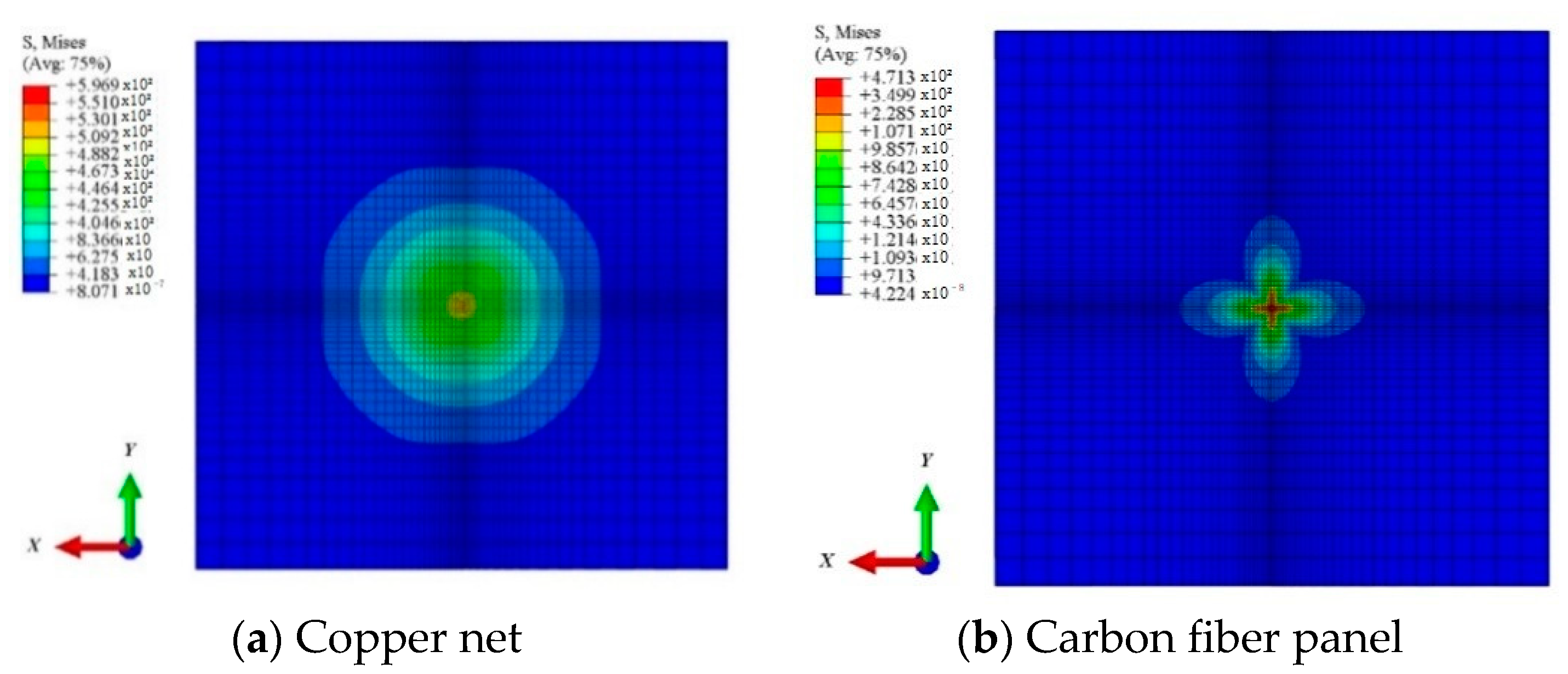
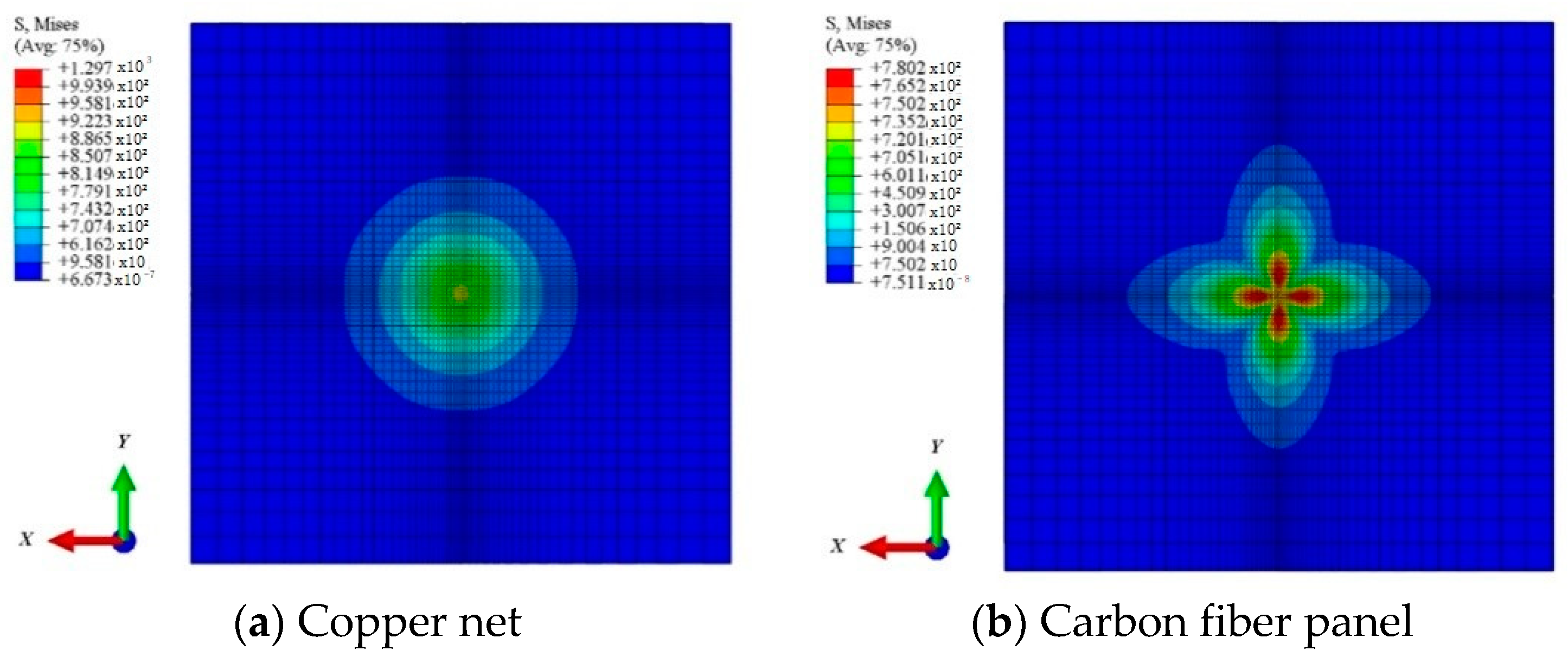
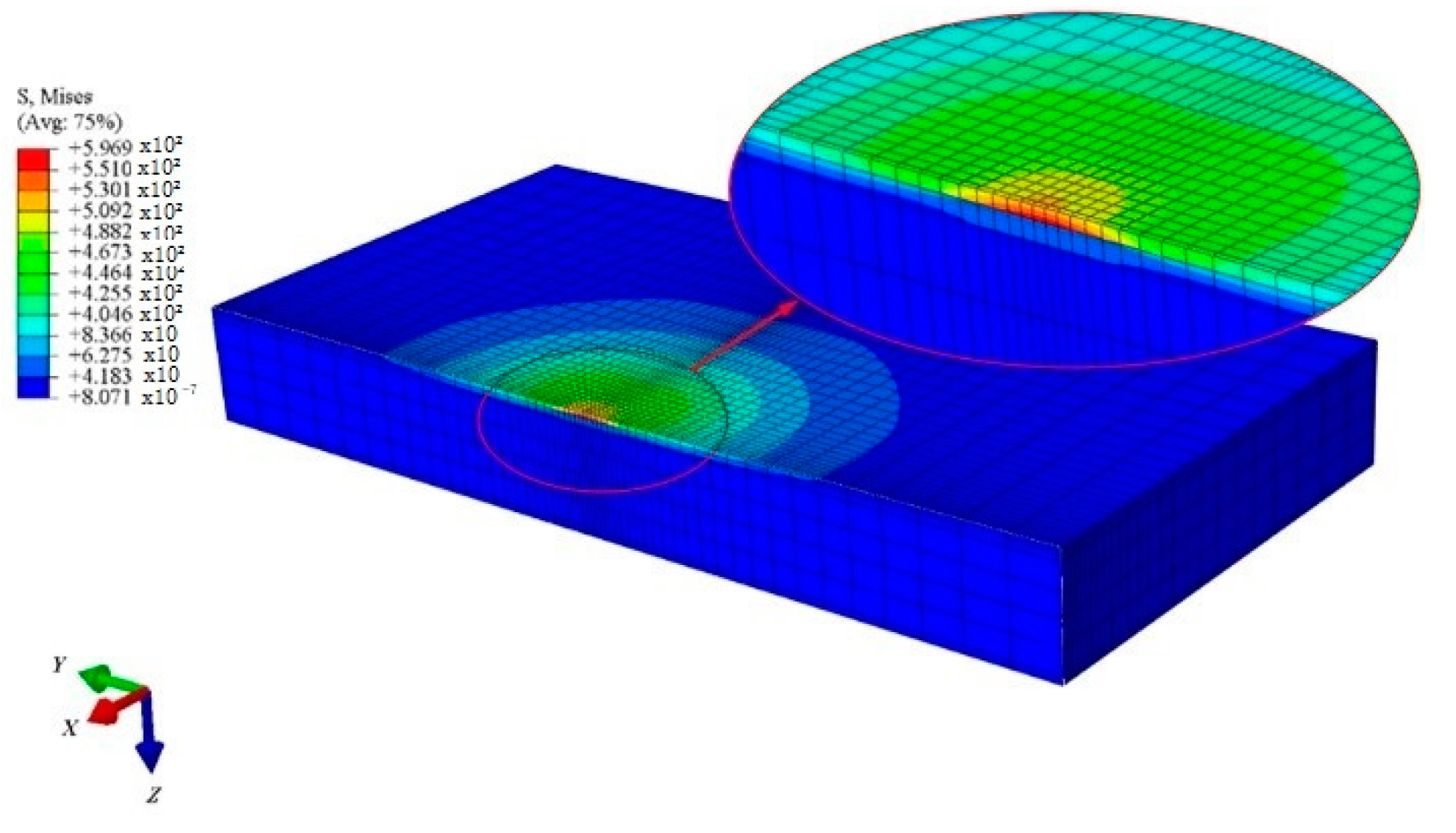
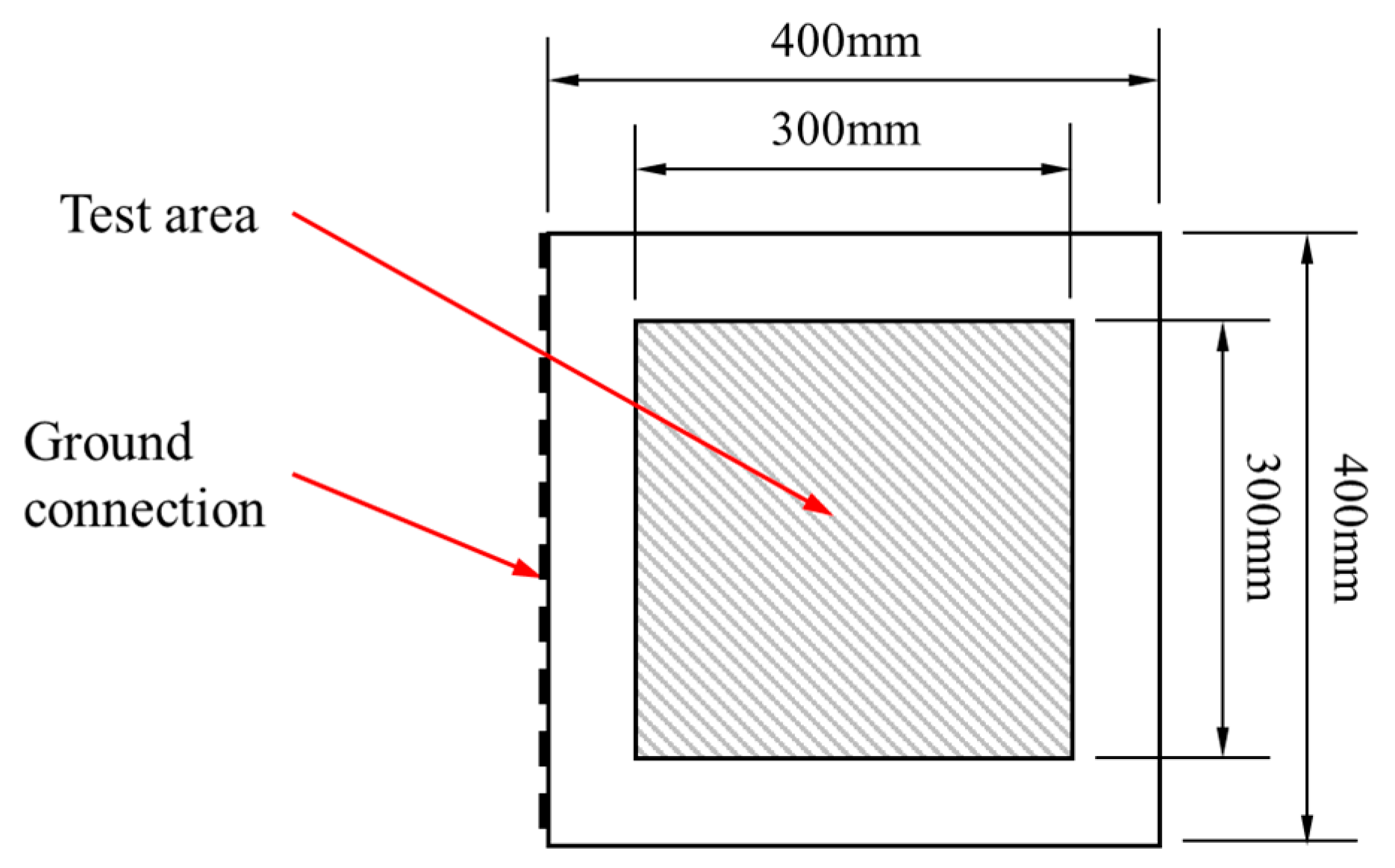
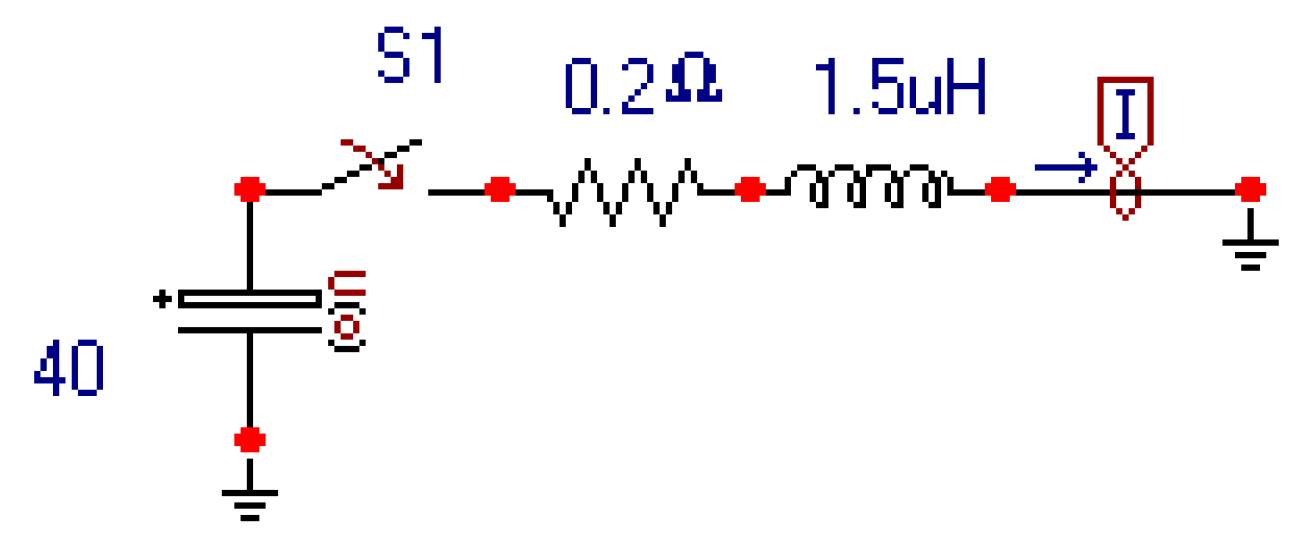


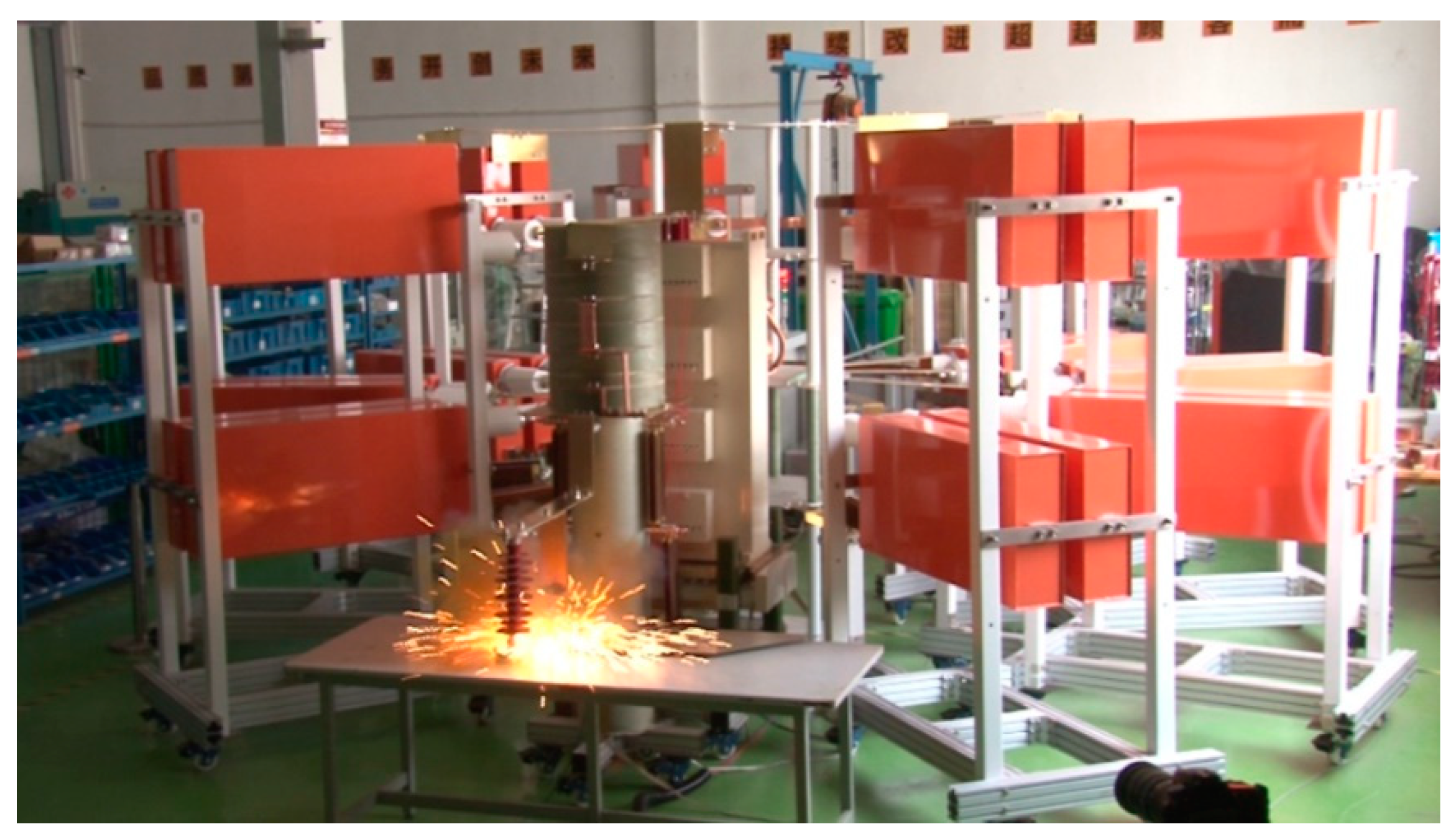
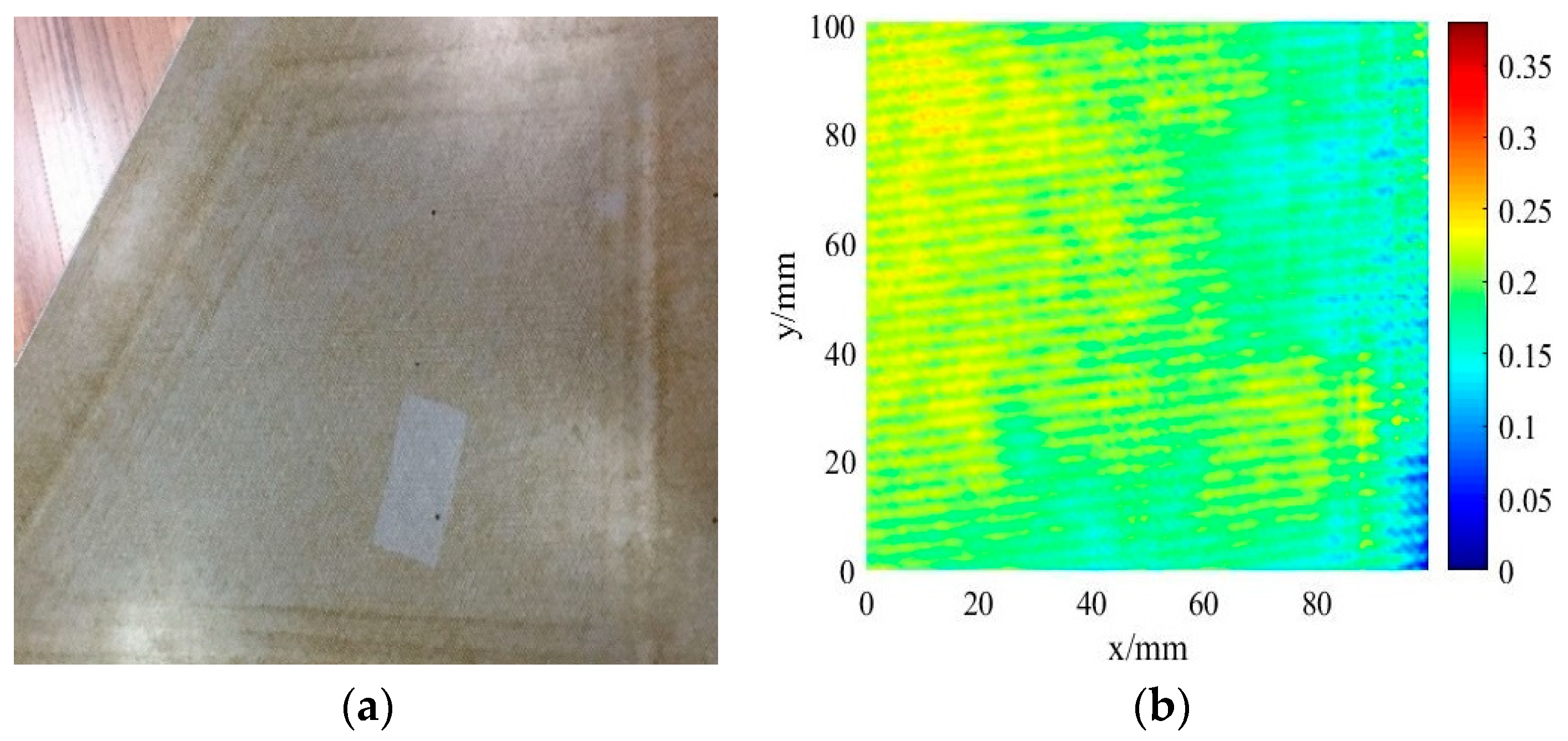
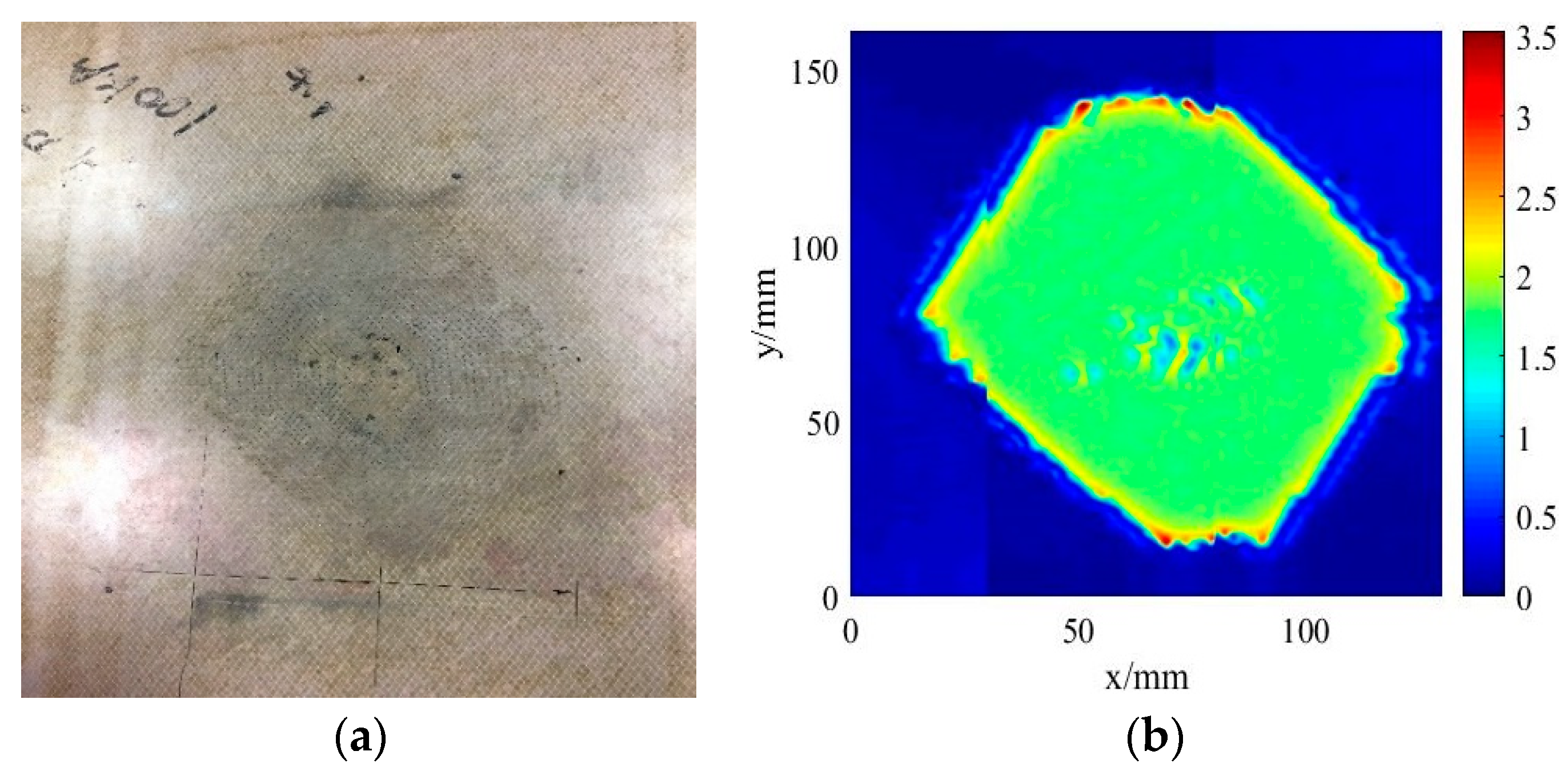

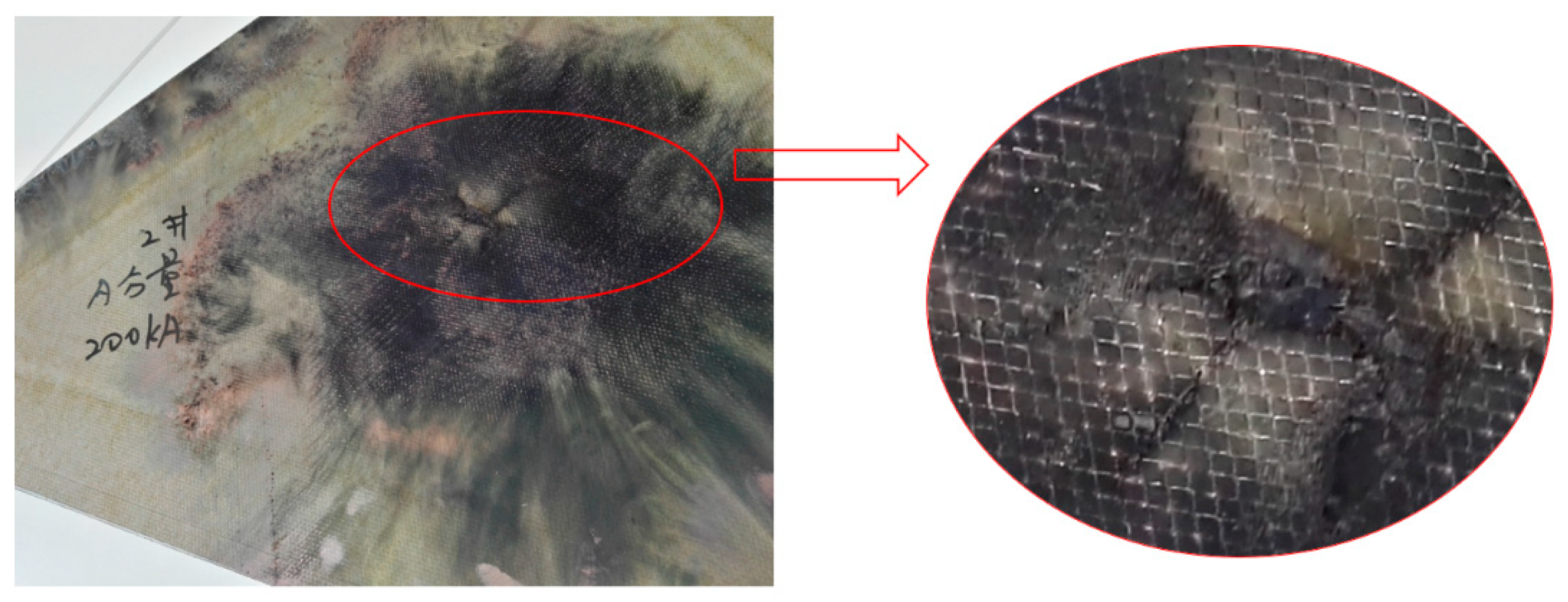
| Material | Longitudinal Modulus E1 | Longitudinal Strength S1 | Transverse Modulus E2 | Transverse Strength S2 | Shear Modulus G12 | Shear Strength S12 | Poisson’s Ratio -12 v12 |
|---|---|---|---|---|---|---|---|
| CFRP | 56.1/GPa | 650/MPa | 55.8/GPa | 630/MPa | 3.65/GPa | 100/MPa | 0.06 |
| Honey-comb | 3.3/MPa | 0.98/MPa | 3.3/MPa | 1.51/MPa | 260/MPa | 2.13/MPa | 0.59 |
| Material | Elastic Modulus | Yield Strength | Poisson’s Ratio | ||||
| Copper | 119/GPa | 500/MPa | 0.33 | ||||
| Material Items | Electrical Conductivity (S/m) | Thermal Conductivity (W/m/°C) | Specific Heat Capacity (J/kg/°C) | Thermal Expansion Coefficient | |
|---|---|---|---|---|---|
| CFRP | Longitudinal | 2.89 × 103 | 11.8 | 912 | 5 × 10−6 |
| Transverse | 2.68 × 103 | 11.6 | 912 | 5 × 10−6 | |
| Through-thickness | 3.24 × 102 | 10.1 | 912 | 4 × 10−5 | |
| Copper | – | 5.8 × 107 | 410 | 386 | 1.67 × 10−5 |
| Honeycomb | – | 2.51 × 102 | 0.25 | 1200 | 1.85 × 10−5 |
| Temperature (°C) | Specific Heat (J/kg/°C) | Longitudinal Thermal Conductivity (W/m/°C) | Transverse Thermal Conductivity (W/m/°C) | Through-Thickness Thermal Conductivity (W/m/°C) | Longitudinal Electrical Conductivity (S/m) | Transverse Electrical Conductivity (S/m) | Through-Thickness Electrical Conductivity (S/m) |
|---|---|---|---|---|---|---|---|
| 25 | 912 | 11.8 | 11.6 | 0.67 | 2.89 × 104 | 2.68 × 104 | 7.54 |
| 343 | 1500 | 6.0 | 6.0 | 0.18 | 2.91 × 104 | 2.72 × 104 | 8.52 |
| 500 | 1520 | 2.8 | 2.4 | 0.1 | 3.42 × 104 | 2.77 × 104 | 25.4 [24] |
| 525 | 1170 | 2.3 | 1.9 | 0.1 | 3.42 × 104 | 2.77 × 104 | 25.4 |
| 1000 | 1170 | 1.4 | 1.3 | 0.1 | 3.42 × 104 | 2.82 × 104 [42,43,44,45] | 25.4 |
| 3316 | 1170 | 1.4 | 1.3 | 0.1 | 7.43 × 103 | 7.57 × 103 [42,43,44,45] | 25.4 |
© 2019 by the authors. Licensee MDPI, Basel, Switzerland. This article is an open access article distributed under the terms and conditions of the Creative Commons Attribution (CC BY) license (http://creativecommons.org/licenses/by/4.0/).
Share and Cite
Hu, T.; Yu, X. Lightning Performance of Copper-Mesh Clad Composite Panels: Test and Simulation. Coatings 2019, 9, 727. https://doi.org/10.3390/coatings9110727
Hu T, Yu X. Lightning Performance of Copper-Mesh Clad Composite Panels: Test and Simulation. Coatings. 2019; 9(11):727. https://doi.org/10.3390/coatings9110727
Chicago/Turabian StyleHu, Ting, and Xiongqing Yu. 2019. "Lightning Performance of Copper-Mesh Clad Composite Panels: Test and Simulation" Coatings 9, no. 11: 727. https://doi.org/10.3390/coatings9110727





